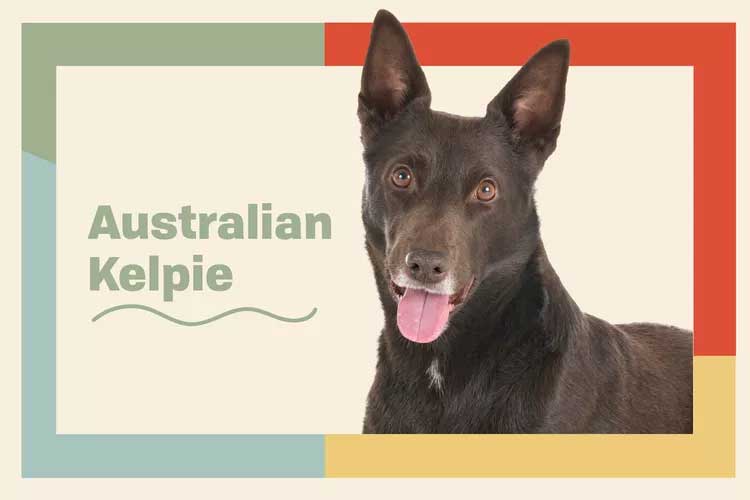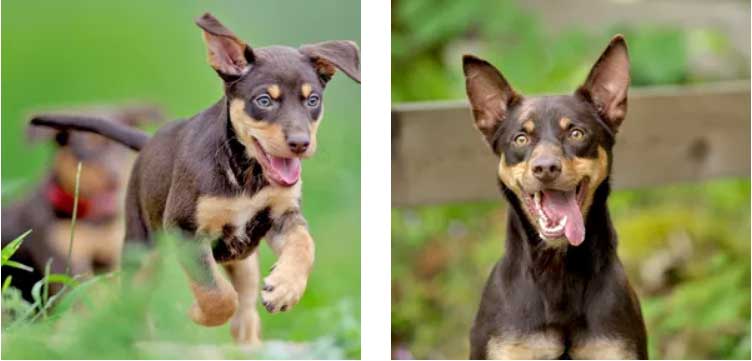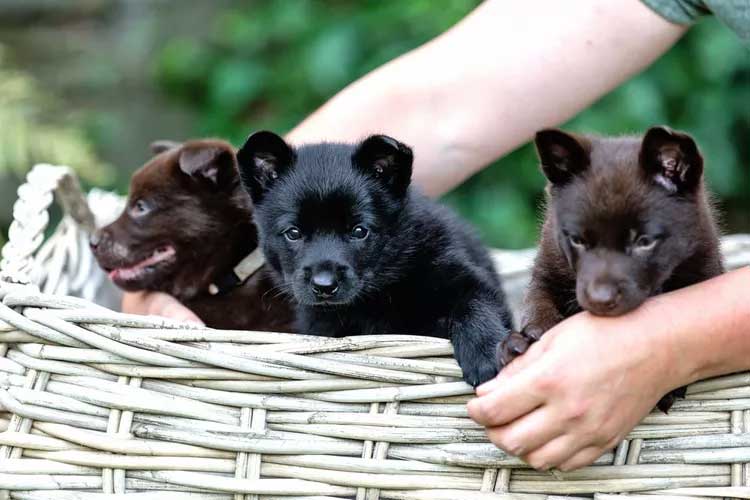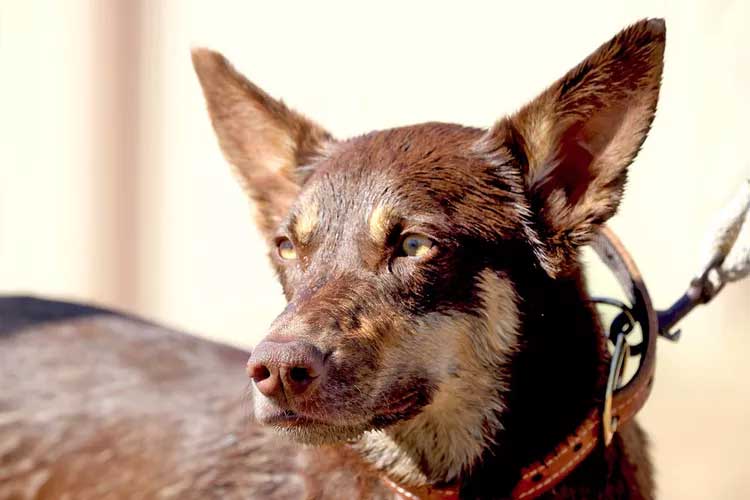Bred as working dogs, Australian kelpies still love being put to work whether their task is herding sheep, catching a ball, or making it to the finish line of an agility course. They require lots of exercise and mental stimulation and make great pets for active families who want energetic, affectionate, and loyal companions.

Australian Kelpie Overview
| OFFICIAL NAME | Australian Kelpie |
| COMMON NAME | Australian Kelpie |
| PET HEIGHT | 19 to 25 inches |
| PET WEIGHT | 28 to 60 pounds |
| LIFESPAN | 12 to 15 years |
| GOOD WITH | children, dogs, families |
| TEMPERAMENT | friendly, gentle |
| INTELLIGENCE | high |
| SHEDDING AMOUNT | infrequent |
| EXERCISE NEEDS | high |
| ENERGY LEVEL | active |
| VOCAL LEVEL | when necessary |
| DROOL AMOUNT | low |
| BREED GROUP | herding |
| BREED SIZE | medium (26-60 lbs.) |
| COAT LENGTH | short |
| COLORS | black, blue, brown / chocolate / liver, cream, fawn, red |
| PATTERNS | bicolor, black and tan, tricolor |
| OTHER TRAITS | easy to groom, easy to train, good hiking companion, hot weather tolerant, loves water, tendency to chew, tolerates being alone |
Australian kelpies were bred to herd sheep across vast expanses of rugged terrain, all the while retaining their working dog spirit. They make excellent hiking partners and excel at flyball, agility, and other sports that require a combination of mental and physical stamina. Kelpies are as devoted to their families as they are to their flocks and make loyal companions that enjoy spending time with their owners—especially if it involves high octane activities.
As their name suggests, Australian kelpies are more popular on the island nation where the breed developed and are not as common in the U.S. But kelpie-lovers in the States shouldn't stress: There are national breed clubs and a few Australian kelpie rescue groups that specialize in the breed for owners who fall in love.
Appearance
At first glance, the Australian kelpie might be mistaken for a mixed breed "mutt" with the pricked ears and curling tail of a German shepherd; the short, shiny hair of a smooth-coated border collie; and the black and tan coloring of a Rottweiler, but these medium-sized dogs are a breed all their own.
Kelpies are strong, muscular dogs. Despite an average height of 17–20 inches, they can weigh up to 60 pounds. Their sturdy, compact bodies are covered in short fur that consists of a dense undercoat and outercoat of thick, straight hair. Black and tan is the most common color, but the breed's fur can range from pure black, chocolate, and red to fawn and smoke blue. Some kelpies also have yellow coats, which led to a long-held belief that the breed descended from the dingo, according to Claire Wade, PhD, professor of animal genomics at the University of Sydney.
Kelpies have a "wash and go" coat that requires minimal grooming—though working dogs or those that spend a lot of time hiking or engaged in other outdoor activities might need more regular brushing or baths.
Temperament
If kelpies could talk, their favorite words might be, "Let's go!" The dogs, whether bred for work and those bred as companions, have stamina to spare. Kelpies do best in homes that provide lots of exercise—a short walk around the block is not enough to satisfy their need to be on the go. Hiking, swimming, and romps at the dog park are excellent activities to help kelpies burn off some of their energy.
"They also make really great sporting dogs for [activities like] flyball or agility or dock diving," Wade says.
Australian kelpies might have go-go-go personalities, but don't count them out for movie night. They're just as happy to curl up on the couch with you, especially after a full day of activity.
Kelpies are an intelligent breed that requires mental stimulation. Offering puzzle toys or playing games like fetch or hide and seek is just as important as exercise. Before bringing home a kelpie, Wade suggests prospective owners ask: "Can I keep his brain active and provide him a home where he has enough mental stimulation to be happy?"
Living Needs
Kelpies were bred to herd sheep across vast open spaces. While the dogs don't need a farm and a flock to thrive, they do appreciate a large fenced yard and lots of opportunities for exercise."This is not so much a dog for a Manhattan apartment with a doggy potty," Wade says. "The owners who have been living successfully in the suburbs [with kelpies] are the ones who do something active with them, like agility or other activities that require them to use their brain. You can't just lock them up in the backyard."
Kelpies are outgoing and sociable and can live in harmony with children and other pets. But, thanks to their instincts, they may attempt to herd them. Consistent positive reinforcement training is a must so kelpies learn to be on their best behavior and don't try to treat family members like sheep.

Loyalty is also a hallmark of the breed. Because kelpies were bred to work alongside farmers and animals, they develop strong bonds with their owners and fellow family pets. They prefer spending time with their pack to being alone.
Care
The Australian kelpie a low-maintenance breed that requires minimal grooming. An occasional bath and regular brushing to remove excess hair are all it takes to keep your kelpie looking his best, and nail trims are also essential to prevent overgrowth. Like all breeds, Australian kelpies require regular vet care, vaccines, parasite prevention, and dental care.Thanks to their eager-to-please personalities, training Australian kelpies is a breeze. Their training should focus on rewards and, as with all breeds, positive reinforcement. Because kelpies love to have a job to do, using games and fast-paced activities during training will help them master basic commands and learn new tricks. Skip long, repetitive training sessions and focus on short, high-energy training routines instead. If kelpies feel like learning new things is their job, they'll work hard to excel.
Health
Despite being hardy working dogs with a lifespan of 12–15 years, Australian kelpies are prone to a couple health conditions. Hip and elbow dysplasia, a skeletal condition that causes the ball and socket of the joints to rub and grind together, are common in kelpies.A common genetic disease known as cerebeller abiotrophy, or CA, also impacts kelpies. Wade notes that there are two forms of the disease: One affects Australian kelpie puppies and the other affects adult dogs. CA affects the cerebellum, the part of the brain that regulates movement; it can cause lack of balance and coordination and dogs with the disease often have a wobble in their walk. When it's diagnosed in puppies, it can be overcome. But older dogs diagnosed with CA tend to have a worse prognosis.
"Older dogs [diagnosed with CA] tend to degenerate quickly," Wade explains. "It's a progressive disease that gets progressively worse and the dogs don't usually don't survive."
If you notice any signs of CA in your pup, alert your veterinarian. There is a genetic test that can give a prognosis.
History
There are two major origin stories for the Australian kelpie. In the first, Australian farmers purchased working dogs from Scotland; the dogs were cheap because their pricked ears were prone to frostbite in the harsh climate of the Highlands (but they were perfect in Australia, where the shape of their ears helped dissipate the heat).
The locals noticed the imported working dogs had the same pricked ears, sturdy builds and black and tan or yellow coats as the dingo, the native dog of Australia. The similarities in their appearance led to rumors that the breed was developed from a cross between a Scottish collie and a Dingo.
"It fit into the local folklore of tough Australians who felt like a bit of an outcast, and so that was one of the stories that flourished," Wade explains. "They like to claim that's why they do so well in our harsh conditions."
In a separate version of the origin story, farmers were believed to tie out female dogs in their sheep pastures to lure in dingoes to kill them (and keep the dingoes from killing the sheep) but the wild dogs bred with the working dogs, resulting in a cross that is now known as the Australian kelpie.

However, Wade has debunked the dingo connection. In her 2019 research, she found no detectable dingo DNA in the Australian kelpie.
"I can't say for certain there has never been dingo in there," she admits. "But I'm pretty certain there's not much left if there ever was [a connection]."
Regardless of how the breed originated, the Australian kelpie remains one of the most popular breeds in Australia where it is prized for its work with sheep and as a companion.
Fun Facts
In 2011, an Australian kelpie named Abbie Girl hopped onto her surfboard in San Diego and surfed a wave measuring 351.8 feet, earning her a spot in the Guinness Book of World Records for the longest wave surfed by a dog.A kelpie cross named Ozzy holds the world record for crossing a tightrope in 18.22 seconds.
A kelpie is the title character in Red Dog, a novel about a nomadic dog that lived in Dampier, Australia, and became a beloved fixture in the mining town. A monument of the dog still stands in town. In 2011, the book was made into the award-winning film, Red Dog.